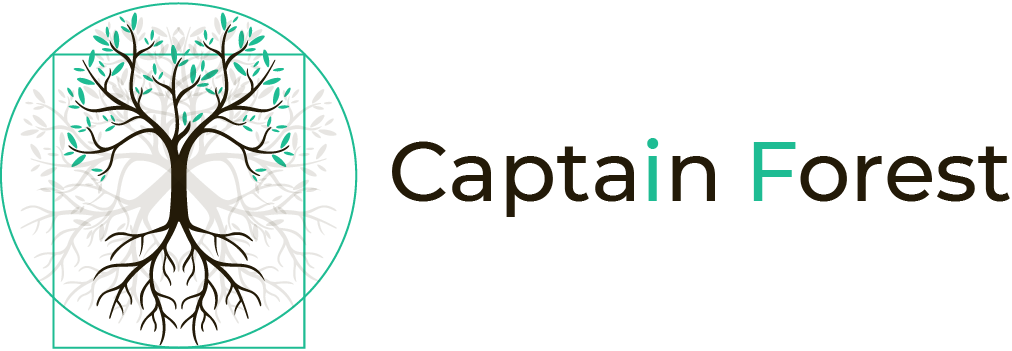How I Eliminated 80% of Plastic From My Life in One Year?

In this article I’m sharing with you how I eliminated 80% of plastic from my life in one year. I hope this testimonial will help others in their plastic-free journey.
Why eliminate plastic from my life?
I‘ve heard of people doing their ecological transition for many years and never really knew what it meant. Since 2015, I have started having a healthier lifestyle, buying organic food, consuming more responsibly, avoiding waste, and giving up on over-consumption habits.
At that time, I was 100% certain I was living in a way that respects Nature.
In 2018, I worked on a project to analyze how to influence consumers to behave in a sustainable way. One of the professionals I interviewed raised my awareness about plastic use and the damage it has on the environment.
He explained that it is hard for a person throwing away a plastic bottle in Paris to imagine this action’s negative impact on the environment. This same person wouldn’t throw that plastic bottle in the ocean because s/he is less distant from the environmental impact it would have. However, from an ecological point of view, throwing a plastic bottle in the garbage in Paris can also hurt the environment since that bottle might end up being incinerated (1).
Further research made me realize that some developed countries sell their trash to other developing countries, and the waste (especially plastic) ends up in the ocean (2).
I understood I was ignorantly polluting the environment every day. Therefore, starting in 2019, I gradually stopped buying plastic water bottles and habituated always to carry my bottle.
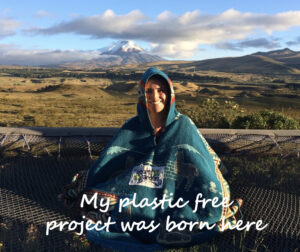 Later, following a very intense trip in Ecuador, where I was completely immersed in Nature, in between volcanoes and the jungle, and after several conversations with local guides and hosts explaining the extinction of so many animals and the destruction of natural habitats, I realized that I can’t keep living in a way that hurts Nature.
Later, following a very intense trip in Ecuador, where I was completely immersed in Nature, in between volcanoes and the jungle, and after several conversations with local guides and hosts explaining the extinction of so many animals and the destruction of natural habitats, I realized that I can’t keep living in a way that hurts Nature.
After this trip, I committed to change the way I live. What can I do to lower my negative impact on the environment? Among several options, I chose to focus on the plastic problem.
Therefore, I decided to eliminate plastic from my life for one year.
Why can eliminating plastic seem impossible?
At the end of the first day (September 29, 2019), I went to ‘Galleries Lafayette’ to buy a barrette – a simple hair clip. Once there, I realized that all affordable ones (about less than 30 euros) were made of plastic. I didn’t want to spend 100+ euros on a plastic-free barrette.
I knew I had several brand-new barrettes at home, so I decided not to buy a new one. Walking back home, I was impressed with myself for resisting that temptation.
On the fourth day, I went to the supermarket and noticed the PLASTIC INVASION for the first time in my life.
Almost every single product had a plastic packaging: salads, yogurts, cheese, pasta, rice, lentils, tea, liquid soaps, solid soaps, dentifrice, Q-tips, cotton, toilet paper, toothbrush, everything. PLASTIC INVASION.
I was looking around, and my heart was thumping. I left the supermarket breathless. Great, what am I going to do now? Am I supposed to starve? Should I really give up on everything I like? That special yogurt, my favorite mint sweet, pasta without grated cheese?!
I didn’t want to stop my project after only four days. It would have been a great disappointment. I committed to do this project for an entire year.
Let’s find ways to replace all those products.
How did I reduce plastic in the food?
Results after a year
It took me nine months to figure out how to replace all the plastic-packaged products I used to buy. Now, 95% of the food I purchase is plastic-free.
Consuming plastic-free food has meant mainly buying unprocessed food and, therefore, purchasing ingredients and then preparing them myself.
Plastic-free solutions for food:
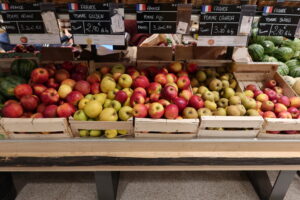 Vegetables and fruits: because my 0-plastic project was also about meaning, as a plus, I decided this year to buy vegetables/fruits produced locally and grown ecologically with gentle agricultural methods. Buying local seasonable products means having few options during the winter, but I decided it would be part of the experience. Eventually, I learned about the variety of seasonable products that grow in nearby regions.
Vegetables and fruits: because my 0-plastic project was also about meaning, as a plus, I decided this year to buy vegetables/fruits produced locally and grown ecologically with gentle agricultural methods. Buying local seasonable products means having few options during the winter, but I decided it would be part of the experience. Eventually, I learned about the variety of seasonable products that grow in nearby regions.- Cheese: replacing cheese packaged in plastic in supermarkets was very feasible. I started to always go to cheese mongers – better quality products and less plastic for the planet.
- Milk: Be careful; replacing plastic bottles with cardboard bottles is not the solution. One solution is to buy fresh milk contained in glass bottles. Generally, I have drastically reduced my consumption of milk.
- Yogurts: in supermarkets, they are almost all packaged in plastic cups. Very few brands sell them in glass containers. Even better, buying a machine to make homemade yogurts is possible.
- Starchy food, lentils, seeds, dried fruits, and so forth: it took me a while to find a
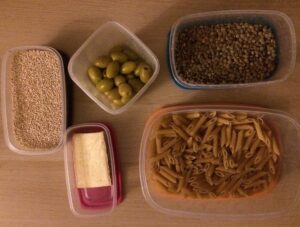 sustainable solution. In Paris, numerous stores offer loose goods. However, I discovered that some of these goods are first packaged in plastic bags before being displayed. I queried store managers about this, and they confirmed it was true. It seems like the problem of plastic waste is being passed on to the stores. After several months, I found just two shops in Paris that sell loose goods not initially packaged in plastic: ‘Day by Day’ and ‘So Bio’.
sustainable solution. In Paris, numerous stores offer loose goods. However, I discovered that some of these goods are first packaged in plastic bags before being displayed. I queried store managers about this, and they confirmed it was true. It seems like the problem of plastic waste is being passed on to the stores. After several months, I found just two shops in Paris that sell loose goods not initially packaged in plastic: ‘Day by Day’ and ‘So Bio’. - Condiment, sugar, oils, tea, coffee, etc.: a plastic packaging alternative always exists in supermarkets or specialized shops.
Lessons learned from eliminating plastic in the food
To have a plastic-free lifestyle, I totally changed my relationship with food, spending more time carefully selecting ingredients and then cooking them. All of this took me a considerable amount of time, but the reward was in the quality of the food I ate.
Also, I had to change some habits. I started to bring my own receptacle when buying fresh food and to always specify to merchants that I avoid the use of plastic. Indeed, even when I was trying hard to avoid plastic, there were often some unexpected surprises.
For example, I ordered strawberries online from farmers, and when I picked them up a few days later, I realized they were packed in a plastic box.
Likewise, I ordered some olives along with other things from a market. I realized only afterward that the olives were in a plastic bag.
Plastic is everywhere, so it was important to habituate myself always to specify “please no plastic”.
There were some frustrations along the way, but I learned to turn them into creativity.
Once, I was traveling and had no choice but to buy bread packaged in plastic. All stores were closed already, and it was that baguette or nothing. I was renting a little far from the city, and no coffees/restaurants were around.
So, no baguette meant no breakfast for the following day. I was tempted just to buy that baguette, but then I thought: What about making pancakes instead?
How did I manage to decrease my use of plastic in cosmetics?
Results after a year
After a year, I managed to decrease by 70% my consumption of plastic:
- I eliminated 40% of the cosmetics I used to buy,
- I replaced 30% of the products with plastic-free alternatives,
- I replaced 10% of the products with chemical-free but not plastic-free alternatives,
- I kept 20% of the products I used to buy – because I haven’t yet found alternatives.
Steps to eliminate plastic in cosmetics
At first, I thought I found the solution. I considered buying products from a famous “natural” brand that says it recycles its plastic packaging when the client returns the products to the store. Reading serious articles about closing the loop for plastic cosmetic bottles left me with doubts. I decided to walk away and look for other solutions.
I needed a shampoo and didn’t know how to replace my favorite one. I went to ‘Sephora,’ and discussed it with a seller.
“Do you know any brand that packages its shampoo in a non-plastic recipient”. She said, “No, I don’t know any. However, if you’re a green girl looking for green products, you should make your own cosmetics”. “Making my own products, what do you mean?”. “Do it yourself (DIY). You should read blogs to learn how to do that.”
Learning more about this topic, I realized that the primary motivation of some bloggers was to create natural and, therefore, chemical-free products. Are chemicals harmful to the body? I read the book of Rita Stiens‘ the truth about cosmetics’ (3), which tells about greenwashing in the beauty industry and gives a list and classification of chemicals used in cosmetics and the degree of risks they represent for the body. The book convinced me to stop using most cosmetics I used to buy and to start looking for natural alternatives.
Some stores aim to sell natural processed cosmetics. Some of them are plastic-free – such as solid shampoos or other hygiene products – others are chemical but not plastic-free. In total, I have been able to replace a few products I used to buy.
DIY for plastic-free cosmetics
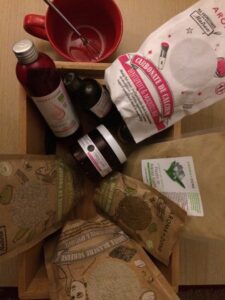 To solve both the plastic and chemical issues, I decided to learn how to make my own cosmetics. However, this adventure took me time: so many books, blogs, and contradictory opinions existed. I needed to sort things out. There is no single recipe that can be applied to everyone. I needed to find the proper ingredients that fit my particular type of hair or skin.
To solve both the plastic and chemical issues, I decided to learn how to make my own cosmetics. However, this adventure took me time: so many books, blogs, and contradictory opinions existed. I needed to sort things out. There is no single recipe that can be applied to everyone. I needed to find the proper ingredients that fit my particular type of hair or skin.
Finally, I discovered a store in Paris, an Alibaba cave for anyone interested in the ‘DIY‘ (do it yourself) concept. I was waiting for the end of the 2020 lockdown to go to this store and buy some ingredients to make my own cosmetics. Finally, the first Saturday morning right after the end of lockdown, I went to that boutique.
What a surprise. I thought I would be alone in the store, but all the girls living in Paris seemed to be queuing there. Is it that famous? On the other hand, some of the ingredients I wanted were packaged in a plastic bag or bottle. I had been waiting for two months to come to the store. Plastic was there again!
PLASTIC INVASION. FRUSTRATION. FRUSTRATION.
Nevertheless, I realized the store’s concept was “DIY” and not “plastic avoidance”. They fairly allow women to create natural cosmetics with good quality products. That day, I bought the ingredients I needed most to make a few cosmetics; some were indeed plastic-free. I thought at least I would learn how to make chemical-free cosmetics.
How did I reduce plastic for other type of goods?
- Households: Plenty of green alternatives to classical household products are sold in supermarkets. Some contain fewer chemicals and, therefore, are less harmful to the lungs and pollute less water. However, they were all packaged in plastic. As an alternative, for the sake of the experience, I started making some household liquids to use less plastic packaging and less chemical products. As a result, I decreased the use of plastic in the household category by 60%. As a plus, I reduced the use of chemicals by 80%.
- Medicine: I am curious to know if there is any alternative to products such as eye drops, antiseptics, etc. I asked some pharmacists, but they were unwilling to have this long conversation with me.
- Electronics: When buying electronic devices, each component has a plastic film around it (strings, battery, screen…). To avoid plastic, the alternative could be to buy second-hand or repair it.
- Other goods packaged in plastic: I tried to make an effort to always look for an equivalent good not packaged in plastic. It is feasible, but it takes time to find alternatives.
- Other goods for long-term use made in plastic:
- I eliminated or decreased the use of some products made in plastic because the non-plastic alternative was easy to find and convenient to use (for example, hangers).
- I bought some goods made of plastic for long-term use because the alternative was inconvenient or did not exist (for example, swimming goggles).
The challenges and motivation during the transition period to become plastic-free
The hard things about my plastic-free journey were:
- Greenwashing: brands have very confusing messages. Moreover, so many contradictory opinions exist in so many blogs and books. In the end, sorting things out was a full-time job.
- Learning process and time needed: learning how to prepare things took me considerable time. For example, to make my own cosmetics, I needed to find a recipe, then source ingredients, later test the recipe, and finally improve my “production process” to get a better product.
- Generalization (/scale): replacing a few products was feasible, but generalizing to all products in a short timeframe took a lot of work.
Consequently, during my project, I decided to have some flexibility and keep purchasing goods that are highly important (for me) and for which I cannot find an alternative in the short term.
However, I committed never to throw out the plastic I use. Therefore, my project turned into a zero-plastic trash one. I stored all the plastic I would have usually thrown away. And I can tell you that accumulating trash in a cupboard was a great incentive to decrease, stop using, and replace plastic products rapidly!
Why not throw out this plastic? First, it is important to mention that the plastic I kept was not dirty at all – dentifrice tubes, old shampoo bottles, plastic films, etc.
Then, I knew that the recycling symbols on product packaging were misleading.
They do not mean that the product will be recycled but that “the producer has made a financial contribution towards the recovery and recycling of packaging in Europe (4).
Moreover, I asked professionals in the recycling industry, who confirmed that only a tiny proportion of the sorted plastic is recycled (5).
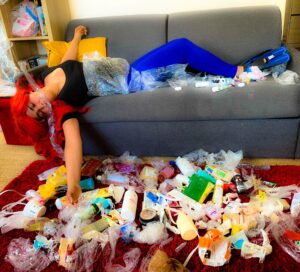
Therefore, I knew that if I trash the plastic I had used, it was unlikely that it would be recycled and more likely end up in the ocean or an incinerator. I tried unsuccessfully to find a solution to recycle the plastic I stored. Recycling the plastic I kept that year will be my next challenge.
How can we collectively eliminate plastic?
When I first started my zero-plastic initiative, I aimed to decrease my environmental impact. I sought to discover and test out substitutes for plastic-packaged items. Thus, this project has allowed me to make my ecological transition.
My project helped me find meaning. Eliminating plastic in food or cosmetics brought me closer to my essence.
I learned how to prepare things myself, discovered what ingredients I needed and where to buy them, learned more about short-distribution channels, and learned more about old traditions and cultures.
My project also changed my relationship with time. Instead of being a fast consumer, I acquired knowledge and became a “producer” at my own pace.
The key for this project was to be open to changing how I lived and give up on things I liked. I did so for the sake of Nature because Nature was so important to me.
However, this argument is insufficient to influence mass consumers to change their habits, even though plastic is a major pollution source, and there is a real emergency to stop this disaster.
How can we change mass people’s behavior towards plastic use?
I often wondered: is it about changing mass people’s behavior or what is available to them? Massively evolving what is available to people implies transforming the whole economic and societal model, doesn’t it? That forces us to think about the “how”, and the question becomes even harder to answer.
If eliminating or decreasing plastic use greatly impacts companies’ operations and business models, some companies could transition to reuse or refill solutions and stop at least unnecessary overuse of single-use plastic.
For example, vegetables/fruits in plastic bags or a 10-biscuit pack having each biscuit packaged in an individual plastic film.
Likewise, if we apply the Pareto principle (6) at the individual level, why not start by eliminating or replacing just 20% of the unnecessary plastic products we buy daily?
To see change around us, we need to embrace it. Change is easy.
References:
(1) https://www.captainforest.com/how-to-influence-consumers-to-behave-sustainably/
(2) https://edition.cnn.com/2019/07/29/opinions/by-exporting-trash-rich-countries-put-their-waste-out-of-sight-and-out-of-mind-varkkey/index.html
(3) ‘The truth about cosmetics’ by Rita Stiens
(4) https://www.recyclenow.com/recycling-knowledge/packaging-symbols-explained
(5) For more information, read the book of Flore Berlingen “Recyclage le grand enfumage” where she describes how the circular economy has become the alibi for disposables
(6) Pareto principle states that 80% of the effects come roughly from 20% of the causes
Thanking
Thanking BFFP for having shared our story in their blog: click here.

